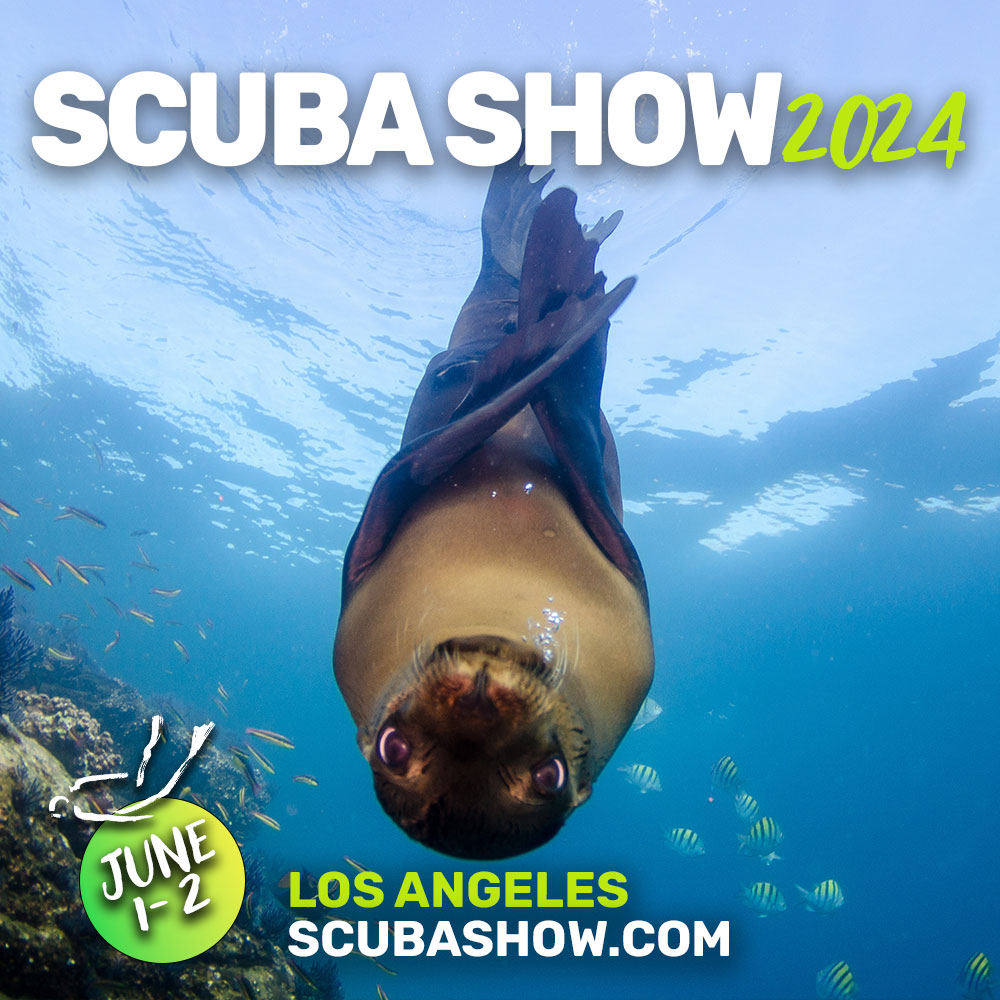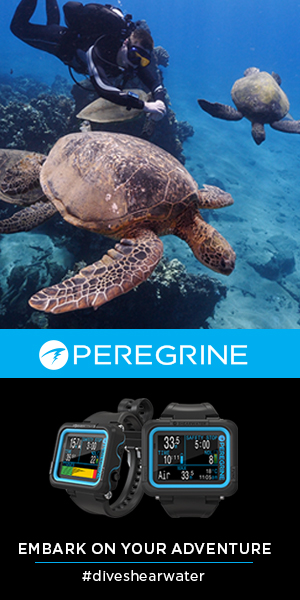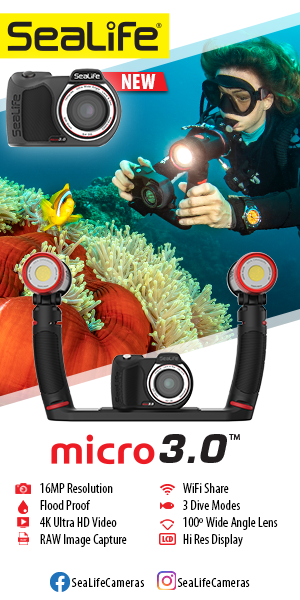Blue. A giant electric ball of it. It looks a little like Earth from space, complete with satellites — in this case, a spinning swarm of silversides. It’s the only light illuminating the Blue Cave, and it leads the way out, whenever I choose to get off my lone perch in this hidden amphitheater and leave this little secret hideaway behind.
For now, though, there’s no need to hurry.
Yet, somewhere through that passage bobs the little motorboat from Playa Santa Cruz. Getting there today will be an easy snorkel-through, past a little reef knob patrolled by a couple of parrotfish. But when the Caribbean gets into a bit of a nit, you’re acting on faith that there really is something on the other side of a wall of ancient coral.
Then again, that’s part of the allure of secret hideaways: in-the-know magic.
Like this.
For divers, Curaçao is a genuine life-list destination. Only 35 miles (56 km) off the northern coast of Venezuela, between Aruba and Bonaire, it’s a quaint 37-by-6-mile (59-by-9.6-km) patch of rolling limestone and volcanic rock poking out of the southern Caribbean. But as a dive getaway, it packs a hefty punch in that little space.
Mostly that’s because for every adventure underwater it offers ones topside, too. Its unique history, culture and geography make Curaçao a worthy trip, even if you didn’t already know how to swim. But the diving — well, let’s keep that our little secret.
Location, Location, Location.
Curaçao came into the western world the usual way: It, and the Caquetio Indians who’d already inhabited it for several thousand years, were “discovered” by Spanish explorer Alonso de Ojeda in 1499. The Spanish were looking for gold and, indeed, they struck it when they shipped those Indians off to other colonies as laborers — but not before attributing the name of the conscripted tribe to the island. At least that’s one guess at the origin of the island’s name. Another suggests that “Curaçao” comes from the Portuguese word for healing, curacion; according to this version, sailors were cured of scurvy by eating native plants. Yet another draws roots to Corazon, since the island was the heart of trade in the area.
Whichever it was hardly mattered. Scant rain made agriculture on the island an unreasonable challenge, and with it, colonization. Case in point: The beloved Valencia oranges brought by Spanish colonists in the 1500s turned bitter, small and inedible in the poor soil — eventually growing into a separate species. Goats and cows, tended by the Indians who weren’t shipped off to Hispaniola, fared better, but Curaçao ultimately was deemed an Isla Inutile, or “useless island.”
If the Spanish were ho-hum, the Dutch were more visionary. By 1634, they’d provided the Dutch West India Company (WIC) with a monopoly in the Americas, with Curaçao as the centerpiece. The WIC’s first plantations were built in 1650 under the governorship of Peter Stuyvesant — padding the resume that would soon make him governor of New Amsterdam in the American Northeast — and by 1665 Curaçao’s natural deep-water port was the hub of international trade between Europe, America and South America, particularly for salt — as well as seedier goods: slaves. Indeed, at the height of the trade, nearly half the slaves destined for the new world passed through the island’s market. The local Papiamento language is a legacy of that; it’s a stew of African, Portuguese, Spanish, English and Dutch.
Save for some troubles with the English and French, not to mention the ever-present threat of slave revolt and pirate attacks, the Dutch held nearly continuous rule over Curaçao, even after the WIC went bankrupt in the early 1700s. That required Curaçao to bristle with forts, including Fort Amsterdam, built in 1635, Fort Waakzaamheid, built in 1803, and Rif Fort, built in 1828. A bit farther to the southeast, on Caracas Bay, is Fort Beekenburg, one of the best-preserved forts in the Caribbean. Details are sketchy, but the cannonball lodged in the Dutch Reformation Church in Fort Amsterdam may have been fired from Fort Waakzaamheid by troops under Captain Bligh (of HMS Bounty fame) during a siege in 1804.
Yet by the 1860s, countries around the western world had abolished slavery. Curaçao slipped into hibernation until Royal Dutch Shell built an oil refinery just prior to World War I to process crude from Venezuela’s Maracaibo Basin. The boom attracted workers from nearly 50 countries, and Curaçao entered its second, cosmopolitan act — one of regional banking, trade and, eventually, tourism.
Picture Perfect
Curaçao was already one of the most architecturally important islands in the West Indies (Willemstad was inscribed on UNESCO’s World Heritage list in 1997); it’s the only fortified capital city in the Caribbean done in the Dutch style — that is, with narrow alleys, curved Dutch- and neck-gable ends under steeply pitched tile roofs, and open-air plazas, or pleins. Building it, though, required some ingenuity; instead of clay, builders used bricks of coral, and then plastered the uneven facades. They added galleries and shutters to shade windows from tropical sun and employed pastel colors — supposedly because bright-white plaster gave an early governor a headache. The result is a one-of-a-kind cityscape, and Willemstad comprises the sum of its parts.
On the east side of the Saint Anna Bay is Punda, or “the Point.” Once enclosed on three sides by Fort Amsterdam, it outgrew those bounds, and eventually the fortress walls were razed. Nowadays, it’s a shopping district, with offerings that you’d expect to see in an international mall. Along the Waaigat canal, you’ll also find the Floating Market, a collection of colorful fishing boats that bring fruits, vegetables and art-and-craft items from around the Caribbean. The seat of government for Curaçao — indeed, all of the Netherland Antilles until last year, when Curaçao became an independent nation within the Kingdom of the Netherlands — resides at the Governor’s Palace, as does the church with the cannonball.
Across the Queen Emma pontoon bridge, which swings wide for passing ocean freighters, is Otrabanda — literally, “the other side.” More than a half-century younger than Punda, Otrabanda’s winding streets were first home to stately mansions, then workshops and apartments for craftsmen and artists. It still keeps an artistic vibe as home to the Curaçao North Sea Jazz Festival, at the World Trade Center on Piscadera Bay. It also offers more opportunities for shopping, dining, disco dancing, and casino gambling.
Speaking of dining, Curaçao’s melting pot boils over in its offerings of food. Both white-tablecloth and sidewalk cafés offer Latin, European, Indonesian, Caribbean, Suriname, Chinese, American and Indian cuisine, but for local flavor, the Old market (MarsheBieuw) in Punda offers lunchtime Kriyoyo — assorted goat, fish, beef, beans, stews, root vegetables, plantains, and cactus soup done Curaçao style.
For even more “Curaçao style,” those bitter Spanish oranges didn’t go to waste; they’re the magic “something-something” in Curaçao liqueur; the oily, aromatic skins steep in alcohol with secret formulas of botanical herbs for up to seven days. The 17th-century estate Landhuis Chobolobo will fill in the details; they’ve been making it since 1896.
Even more local color comes during Curaçao’s Carnival, which starts with the Tumba Music festival in late January — tumba is the native music style that’s somewhere between merengue and calypso — and continues through the Grand Parade on the Sunday before Ash Wednesday and the farewell parade on Fat Tuesday. Then, an effigy of King Momo, a symbol of sinfulness and bad luck, is burned to ensure a year of prosperity. On the other end of Lent, locals celebrate with the Parade of Seu on Easter Monday; the folk festival commemorates the historic end of harvest on colonial plantations with colorful costumes and “crop music” played on traditional instruments.
Animal Attractions
Curaçao’s climate has always posed a challenge; it’s nearly as dry as northern Arizona or New Mexico, and outside of Willemstad, the cunucu, or countryside, is essentially desert. There, kadushi cactus grows so tall and spindly that they fall over under their own weight, acacia trees, aloe vera, and prickly pear score the landscape, and the evergreen Divi-Divi tree — an apt national symbol — leans westward, shaped by the constant trade winds.
The best place to take in this natural view is Christoffelpark, on the northwestern end of the island. The centerpiece and namesake of the park is Mount Christoffel, the highest point in Curaçao (and the Dutch Leeward islands, for that matter) at 1,230 feet (373 m). If you’re up for an early start to beat the heat of the day, a round trip to the top will take a couple of hours; if not, other hiking trails and driving routes crisscross the park.
Either way, the park abounds with wild orchids, more than 160 species of birds — including the palabrua, a native white barn owl, hummingbirds, bananaquits, chuchubi mockingbirds, yellow-breasted orioles, and warawara falcons — as well as wild goats, Curaçao white-tailed deer, fruit bats that pollinate many of the cactuses, and lizards, especially green iguanas. At the park entrance, the newly renovated Landhuis Savonet offers a high-tech museum highlighting life on the plantations of the 17th and 18th centuries.
Just to the north of Christoffel Park is National Park Shete Boka, a rugged limestone stretch of inlets where powerful north-shore waves thunder through sea caves. The park’s more sheltered coves are sea turtle nesting sites.
Closer to civilization — actually, very near the airport — is Hato Caves, Curaçao’s largest limestone caverns, formed by erosion as sea levels waxed and waned over the millennia. Inhabited by the eight species of bats that call Curaçao home, as well as spectacular stalactite and stalagmites, the caves also have petroglyphs created 1,500 years ago by the Indians who first inhabited the island. Escaped slaves used them as hideouts during Curaçao’s colonial times, often living there for months, and that history is also highlighted by the world-renowned Museum Kura Hulanda, located at a former slave yard in Willemstad. Other aspects of Curaçaoan culture are explored at a variety of venues, including the Curaçao Maritime Museum, the National Archaeological Anthropological Museum, on architecture tours, or even at a local cooking school that teaches Caribbean cuisine.
Regardless of where you are on Curaçao, opportunities abound for activities of the physical sort — from horseback riding, mountain biking, or Jeep tours through Christoffelpark or other “wildlands,” to sea kayaking through the mangroves in such areas as Piscadera Bay, to windsurfing, wakeboarding, sailing or pedal boating closer to one of the resorts.
Coral Paradise
Curaçao boasts 38 public beaches — some secluded, some not so much, and mostly all along the south shore — so if sunbathing and snorkeling is your idea of a surface interval, there’s plenty of that to go around. And, of course, if you’ve not had enough fish, there’s also the Seaquarium, with a collection of more than 400 species of fish, crab, sponges, coral and sea anemones, plus dolphin encounters and dives.
And this is all to say that there’s plenty to keep you occupied during the part of your day that’s not spent underwater on one of Curaçao’s reefs — which is good, because there’s a lot of that diving to go around. All told, Curaçao boasts more than 65 sites in 40 areas.
Much of that owes to the island’s geography below the water; Curaçao is surrounded by fringing reefs that stretch from barely 75 feet (22 m) offshore to nearly 1,000 feet (303 m) into open water. Along the north shore, the far west, and the eastern edge of the south shore, reefs have remained relatively unchanged over the past 30-40 years, according to the Caribbean Research & Management of Biodiversity (CARMABI), a nonprofit marine-research foundation established in 1955. As a result, coral cover can be extremely high — often greater than 70 percent, with more than 60 different coral species found at many sites.
Some of Curaçao’s more famous sites do require a boat ride: the Superior Producer wreck, an advanced site, allows divers to explore a cargo freighter sunk in 1977 that sits upright at about 100 feet (30 m); Mushroom Forest features hard corals that resemble, surprisingly, mushrooms; Klein Curaçao, an uninhabited island of volcanic rock off the southeast coast of the island, is an all-day adventure of its own. Still, just as often, south-side dive sites are accessible from shore.
In most cases, the seafloor descends gradually from sandy plains along the beaches to drop-offs at 20 to 30 feet (6 to 9 m). From there, reefs fall steeply to more than 100 feet — the “blue edge” — where they pitch down even farther into the depths. These shore entries make for easy access to a variety of reef communities, and some bays also access the mangrove-and-sea grass communities that serve as nurseries for many reef fish. By exploring a variety of these marine habitats, you’ll come face to face with many of the more than 350 known fish species in Curaçao — a huge number of total species from an island the size of Curaçao, according to researchers at CARMABI. That led the organization to create the Curaçao Marine Park in 1983 — a designation that stretches from a bit east of Willemstad to the eastern tip of the island, including more than 1,500 acres (600 hectares) of reef and nearly 1,100 acres (440 hectares) of inner bays. Much of that is virtually untouched.
It’s no wonder I’m in no rush.
Outside the Blue Cave, the world can wait. Ultimately, though, there are other places I still want to explore.
But more importantly, I’ve learned a secret too good to keep to myself.




